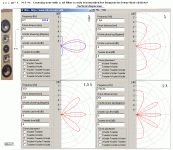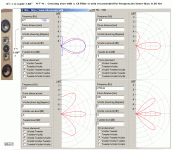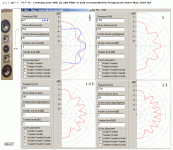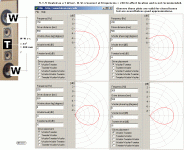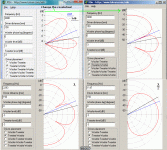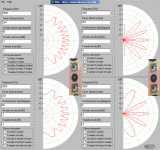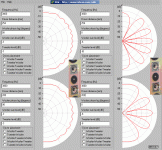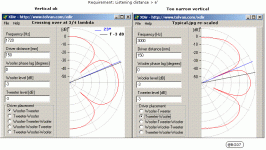Hello,
I would be really interested in thoughts re why in the following scenario, dipole outperforms monopole at higher frequencies; I’d read that the benefits are realised at low frequencies?
OK, so having read all of the great info you guys have shared on this site, and having looked at Linkwitz’s site etc I did something that some of you will consider horrifically crude: took Seas speakers from a couple of boxes I’d been playing with and using wood from an old wardrobe (got to find a use for that Ikea furniture that has the temporal resilience of style found on a catwalk :/ ), I made a front panel that can stand as a dipole or be popped on a box in seconds. Yes, I know it is a huge untuned sealed box, and the tweeter/upper mids are too far apart – i’m going to drop some larger mids in. See thumbnails below.
So it took 2 hours, I threw a crossover together on a breadboard using spare poor quality components (quality perhaps not being an issue according to John[Zaph]), but I’m almost astounded at the resulting MMTMM. Playing it with the lowest speaker of a quad 22L (150Hz crossover (the 0.5 of a 2.5 – no other drivers firing!) to substitute for the not-yet-built low-woofer, the sound is real, articulate and superbly presented, compared to a set of £900 Quad speakers. Oh, and it is in mono I’m astounded how much bass there is even without the Quad filling in the sub 150Hz. Beats quads hands down.
I’m astounded how much bass there is even without the Quad filling in the sub 150Hz. Beats quads hands down. 
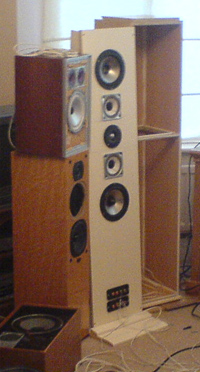
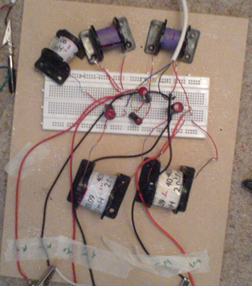
Putting the baffle on the box, the sound is simply not as articulate. Hence question 1:
1) I thought the advantages of dipole were at very low frequencies, which whilst my crossover has no low filter on the 18cm units (really a WMTMW), produces most of its sub 150Hz sound from the monopole quad unit I have running alongside. How can putting the baffle on the box effect the sound so badly? (I must build removable boxes around the mids incase the pressure from lower mids in a box inhibits movement of higher mids)
Second question – a WMT vs a WT using these same drivers, with appropriate crossover for each simply do not compare. Perhaps it is the limits of using drivers at the top and bottom of their recommended frequencies – but inclusion of even a cheap mid driver like this is vastly better to my personal taste, so
2) Is it OK to use two mids like Paul Wright
http://www.geocities.com/pnwright3/Test_Mules.html, or would anyone suggest potential problems?
I would prefer a WW-MMTMM, and put woofers at the bass or separate so speakers aren’t too large and dominant (or the size of a wardrobe door). John (Zaph) again makes good comments here http://www.diyaudio.com/forums/showthread.php?s=&threadid=60634&perpage=10&highlight=&pagenumber=3 but unfortunately the design with ‘Slim with higher quality drivers’ mentioned in this thread didn’t appear on Zaphaudio site to my knowledge. A third question being,
3) Is putting the woofers at the bass (but still in dipole) going to effect the sound?
I would imagine as long as the lower mids are going right down to 200Hz or lower, then it is fine to have woofers at bottom (e.g. Phoenix like http://www.linkwitzlab.com/builtown.htm ,But 3(+woofer) way rather than 2(+woofer) way. Would the sort of room size effect the sound - room is twice as big as this photo (note, speakers firing across room
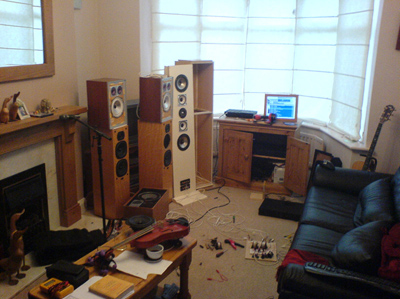
One further thought to keep panels slim would be to keep the bass on the main panel: a WMTMW, replacing those 61/2” seas with 8”. Taking the bass x-over down to 100Hz or lower, then using a sub located elsewhere for the low frequencies. This would keep the panels slimmer. My only concern with using subs is I only use it for 2 channel music (acoustic/classical/electronic/folk/rock... many genres really) – a good bass extension on main speakers ought to be enough without subs.
4) Any views on (a)displaced position sub for lower frequencies + [small-footprint] main panel WMTMW down to 100Hz or lower), vs (b)more musical sub positioned under [larger-footprint main panel extending up to 200Hz or so (main panel MMTMM).
Any comments appreciated. Having no shame, I’ve attached a couple of pictures of my 2 hr construction speaker system (there are some Quads and old leak speakers lurking here too). You can see the box for monopole vs frame for dipole. I’ll build a few more monsters like this based on any suggestions from you people, then start on LSPcad to design things properly. I’ve already found a faulty tweeter can plot similar to a good tweeter (despite sounding awful), so I decided abandoning design and playing would be good before getting back to drawing board to refine whatever I liked the sound of.
Thanks for all the posters on previous threads that I’ve been reading, which got me started; in particular 5th element, Zaph, AJinFLA, Paul W, and ShinOBIWAN. Helpful resource! Also found some biopole info from John Marsh, Thomas W, Paul H on the htguide board – but I’ve no idea of board politics so I’ve not referenced any designs there. I’d hazard a guess there are more 2 channel people here thought, so fingers crossed there are some views on the above.
I would be really interested in thoughts re why in the following scenario, dipole outperforms monopole at higher frequencies; I’d read that the benefits are realised at low frequencies?
OK, so having read all of the great info you guys have shared on this site, and having looked at Linkwitz’s site etc I did something that some of you will consider horrifically crude: took Seas speakers from a couple of boxes I’d been playing with and using wood from an old wardrobe (got to find a use for that Ikea furniture that has the temporal resilience of style found on a catwalk :/ ), I made a front panel that can stand as a dipole or be popped on a box in seconds. Yes, I know it is a huge untuned sealed box, and the tweeter/upper mids are too far apart – i’m going to drop some larger mids in. See thumbnails below.
So it took 2 hours, I threw a crossover together on a breadboard using spare poor quality components (quality perhaps not being an issue according to John[Zaph]), but I’m almost astounded at the resulting MMTMM. Playing it with the lowest speaker of a quad 22L (150Hz crossover (the 0.5 of a 2.5 – no other drivers firing!) to substitute for the not-yet-built low-woofer, the sound is real, articulate and superbly presented, compared to a set of £900 Quad speakers. Oh, and it is in mono


Putting the baffle on the box, the sound is simply not as articulate. Hence question 1:
1) I thought the advantages of dipole were at very low frequencies, which whilst my crossover has no low filter on the 18cm units (really a WMTMW), produces most of its sub 150Hz sound from the monopole quad unit I have running alongside. How can putting the baffle on the box effect the sound so badly? (I must build removable boxes around the mids incase the pressure from lower mids in a box inhibits movement of higher mids)
Second question – a WMT vs a WT using these same drivers, with appropriate crossover for each simply do not compare. Perhaps it is the limits of using drivers at the top and bottom of their recommended frequencies – but inclusion of even a cheap mid driver like this is vastly better to my personal taste, so
2) Is it OK to use two mids like Paul Wright
http://www.geocities.com/pnwright3/Test_Mules.html, or would anyone suggest potential problems?
I would prefer a WW-MMTMM, and put woofers at the bass or separate so speakers aren’t too large and dominant (or the size of a wardrobe door). John (Zaph) again makes good comments here http://www.diyaudio.com/forums/showthread.php?s=&threadid=60634&perpage=10&highlight=&pagenumber=3 but unfortunately the design with ‘Slim with higher quality drivers’ mentioned in this thread didn’t appear on Zaphaudio site to my knowledge. A third question being,
3) Is putting the woofers at the bass (but still in dipole) going to effect the sound?
I would imagine as long as the lower mids are going right down to 200Hz or lower, then it is fine to have woofers at bottom (e.g. Phoenix like http://www.linkwitzlab.com/builtown.htm ,But 3(+woofer) way rather than 2(+woofer) way. Would the sort of room size effect the sound - room is twice as big as this photo (note, speakers firing across room

One further thought to keep panels slim would be to keep the bass on the main panel: a WMTMW, replacing those 61/2” seas with 8”. Taking the bass x-over down to 100Hz or lower, then using a sub located elsewhere for the low frequencies. This would keep the panels slimmer. My only concern with using subs is I only use it for 2 channel music (acoustic/classical/electronic/folk/rock... many genres really) – a good bass extension on main speakers ought to be enough without subs.
4) Any views on (a)displaced position sub for lower frequencies + [small-footprint] main panel WMTMW down to 100Hz or lower), vs (b)more musical sub positioned under [larger-footprint main panel extending up to 200Hz or so (main panel MMTMM).
Any comments appreciated. Having no shame, I’ve attached a couple of pictures of my 2 hr construction speaker system (there are some Quads and old leak speakers lurking here too). You can see the box for monopole vs frame for dipole. I’ll build a few more monsters like this based on any suggestions from you people, then start on LSPcad to design things properly. I’ve already found a faulty tweeter can plot similar to a good tweeter (despite sounding awful), so I decided abandoning design and playing would be good before getting back to drawing board to refine whatever I liked the sound of.
Thanks for all the posters on previous threads that I’ve been reading, which got me started; in particular 5th element, Zaph, AJinFLA, Paul W, and ShinOBIWAN. Helpful resource! Also found some biopole info from John Marsh, Thomas W, Paul H on the htguide board – but I’ve no idea of board politics so I’ve not referenced any designs there. I’d hazard a guess there are more 2 channel people here thought, so fingers crossed there are some views on the above.
Member
Joined 2003
How can putting the baffle on the box effect the sound so badly? (I must build removable boxes around the mids incase the pressure from lower mids in a box inhibits movement of higher mids)
You've got many subjects going on in one post
Any comments appreciated. Having no shame....
Hi,
At what frequency are you crossing over the M to T drivers ? I estimated the c-c distances of your speaker and found this:
See the pictures.
b
1 (4)
Attachments
Paul W said:
in a single box, the woofers will modulate the mids. The mids cannot be contained in the same box as the woofers.
Thanks for that Paul... Yes, I'll certain box in the mids - though I've made a further interesting discovery. Side panels extanding back more than a few inches have the same negative effect on presence as putting it in the box. This obviously makes me suspicious it is not the woofers effect on the mids, but something to do with dipole performance.
Paul W said:
Also, the box in the picture is not nearly stiff enough to be used as a speaker enclosure. Study enclosure construction, then either rework or replace the box; with volume appropriate for the drivers.
Indeed; Sorry, I should have added to that. I'm simply using that box (which is far too thin and inadequately braced) with varying amounts of its volume displaced with further wooden boxes inside to allow me to put boards on the front easily at a very experimental stage. These drivers have been in appropriate sized boxes before, only I wanted to be able to verify very quickly, just by moving the board to the box, whether the dipole configuration or just layout of the board was responsible for the sound I liked. Trying to remember one sound accurately, then compare after building another box and moving the drivers from one to the other is on the challenging side!
It still seems to be related to their being dipoles because of the effect of extensive side baffles as mentioned above.
Yes, I shouldn't have put 4 questions in one email!
bjorno said:
Hi,
At what frequency are you crossing over the M to T drivers ? I estimated the c-c distances of your speaker and found this:
See the pictures.
Bjorno - Fantastic, amongst the bits of software I read up on, I hadn't come across that. I'll have a play around with that! Efforts appreciated.
Thanks for your efforts. The mids are crossed 3.8KHz... but I'm intrigued that Paul's Mules would be likely to suffer some lobing - and I'm pretty sure his site said he used passive for T-M crossover? I'd also hazard a guess they sound good regardless...
Paul?
Thanks guys
Member
Joined 2003
Side panels extanding back more than a few inches have the same negative effect on presence as putting it in the box. This obviously makes me suspicious it is not the woofers effect on the mids, but something to do with dipole performance.
Midrange resonances can develop between OB side panels when the side panels are straight back from the baffle (parallel). It's not the same problem as the box but still a negative result. To break up that resonance, try angling both side panels outward at 45 degrees.
Do you have measurement capability and/or are you using something like the Edge to predict OB results?
Member
Joined 2003
OK, now I'm confused: putting in a typical set of speakers with a 3KHz cross over, and 15cm centre tweeter-centre woofer, I get the attached thumbnail.
This suggests horrible drops in response above and below sweet spot at crossover.
Do I not understand the program? Or would this suggest it is pretty normal to have narrow sweet spots and that they're quite acceptable?
Thanks!
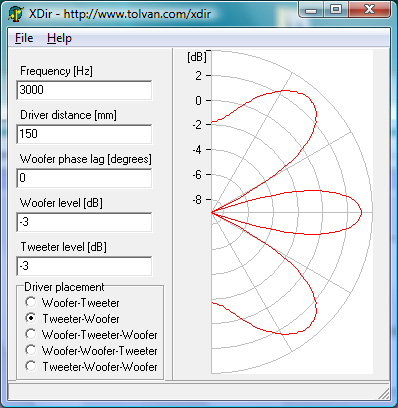
This suggests horrible drops in response above and below sweet spot at crossover.
Do I not understand the program? Or would this suggest it is pretty normal to have narrow sweet spots and that they're quite acceptable?
Thanks!

Paul W said:You posted while I was typing
Yes, "the Mules" sounded good, but it took a year of tweaking to get the best from them. Yes, lobing was one of the compromises made with them, some of it with purpose. (I don't know of a zero compromise speaker).
Ooops. My turn posting while you were typing

Sounds like my thoughts about lobing from my last post are kind of in alignment with your message: that they do exist in many speakers.
I did, based on your design, make shorter baffles and try them at 45 degrees - sure enough I agree that seems good.
I'm quite aware the panel I have in that picture, in its handful of hours crude construction, is only making its first steps, but it so massively outperforms other boxes I've tried, and indeed the Quads in the picture, that either
(a)WWMTM or WMTMW type designs and/or
(b)dipoles
have to be the way to go for this project. If it can sound that good without tweaking, I'd imagine I can only see improvements as I design baffles properly.
That said, on a general note, your mules are one of the most likely designs I would make: would you say the tweaking was worth it or would you do anything differently?
Member
Joined 2003
You understand the program. I wouldn't make a blanket statement that lobing was "quite acceptable", but there is no free lunch. You can reduce lobing by using smaller drivers/closer spacing/lower crossover frequency/etc. For example though, as you can imagine, a lower crossover will impact power handling and driver distortion. Another thing you can do to reduce the impact of lobing is to use very steep (and expensive) filters to minimize the area of crossover overlap. ...it's all about trade-offs!
For a stable and convincing soundstage, I don't think you can beat a symmetrical layout like WMTMW. The weakest link in the Mules was the upper mid and tweeter area. The tweeter didn't have the directionality of the rest of the system so it was difficult to get the in-room balance to sound right. The "Mules" eventually evolved into "Wings"...a large ribbon WTW with a tight vertical pattern.
Four-ways can be very complex with crossover frequencies so close together. A three-way is easier to get right. I would not recommend going beyond a 2-way if you are not using true measurements taken on your baffles. Without actual measurements, even with a 2-way, you would be flying blind.
For a stable and convincing soundstage, I don't think you can beat a symmetrical layout like WMTMW. The weakest link in the Mules was the upper mid and tweeter area. The tweeter didn't have the directionality of the rest of the system so it was difficult to get the in-room balance to sound right. The "Mules" eventually evolved into "Wings"...a large ribbon WTW with a tight vertical pattern.
Four-ways can be very complex with crossover frequencies so close together. A three-way is easier to get right. I would not recommend going beyond a 2-way if you are not using true measurements taken on your baffles. Without actual measurements, even with a 2-way, you would be flying blind.
Paul,
Thanks for that. I'm probably going to go for something Mule like: both aesthetically and from what I've heard from my horrid Bit Of Wardrobe with speakers bolted on, dipoles in that layout seem to produce an astounding sound - perfect for my ears: from acoustic guitar / rock / electronica / folk... I play a few instruments so have a pretty good idea what they are supposed to sound like(I play drums, fiddle, mandolin, guitar and such like). I'd hazard a guess we've all got a good idea what a human voice sounds like too and that layout is highly convincing.
and that layout is highly convincing.
Regarding measurement, i'm using an SM57 equivalent, with a preamp into an old soundblaster 5.1 using justMMS, so I'm fairly happy frequency responses are accurate (exception being very bottom and very top).
Infact, this is partly why I'm playing more than designing: It's certainly proving more productive nudging crossovers around by ear and response plot, rather than sitting designing everything theoretically using impedance and response/phase files for the speakers for days and being disappointed (which is what I did at first).
I'll play a bit more, get some better drivers and make sure my next post is on one topic
Thanks for that. I'm probably going to go for something Mule like: both aesthetically and from what I've heard from my horrid Bit Of Wardrobe with speakers bolted on, dipoles in that layout seem to produce an astounding sound - perfect for my ears: from acoustic guitar / rock / electronica / folk... I play a few instruments so have a pretty good idea what they are supposed to sound like(I play drums, fiddle, mandolin, guitar and such like). I'd hazard a guess we've all got a good idea what a human voice sounds like too
Regarding measurement, i'm using an SM57 equivalent, with a preamp into an old soundblaster 5.1 using justMMS, so I'm fairly happy frequency responses are accurate (exception being very bottom and very top).
Infact, this is partly why I'm playing more than designing: It's certainly proving more productive nudging crossovers around by ear and response plot, rather than sitting designing everything theoretically using impedance and response/phase files for the speakers for days and being disappointed (which is what I did at first).
I'll play a bit more, get some better drivers and make sure my next post is on one topic

array patent
Hi Guys,
I found this patent for a directional bass array which I found interesting.
http://www.google.com/patents?id=8uQaAAAAEBAJ&dq=5642429
Uses 4th order Linkwitz-Riley xover though.
Regards Philip
Hi Guys,
I found this patent for a directional bass array which I found interesting.
http://www.google.com/patents?id=8uQaAAAAEBAJ&dq=5642429
Uses 4th order Linkwitz-Riley xover though.
Regards Philip
The mids are crossed 3.8KHz... but I'm intrigued that Paul's Mules would be likely to suffer some lobing - and I'm pretty sure his site said he used passive for T-M crossover? I'd also hazard a guess they sound good regardless...
charliemouse,
In my opinion, your horizontal dispersion is probably as good as can be and your speaker ‘ sounds’ good, but I find your vertical polar are narrower than necessary, my opinions are only relating to spatial considerations, not the apparent sound quality I even cannot imagine.
I believe, when listening to your speakers and if you’re vertical and horizontal MMA: s is compared; the central phantom vertical azimuth is probably unnecessary enlarged (wide).
My opinion is that to a certain degree, speaker vertical ripple is always acceptable outside the sweet spot area but not within, whether you are sitting or standing up.
The following example is within my own preferences, maybe not yours…but let say that your listening distance is always > 6' and the sweet pot is at 10', then the vertical low rippel dispersion must exceed about 23 degrees positive vertical azimuth if both sitting (about 40"height) or standing (70" ear height when standing up).
The general rule is to crossover (at f) below lambda =344 / f and if (at f) below lamda/2 = perfect.
Look at the new plots 1(4) – 3(4) for your example T-M speaker crossed over at 3 kHz and notice that only by crossing over somewhere between lambda and lambda/2 the proposed listening situation will be fully covered.
Also note that the polar resolution is changed to a normal FR dB span more useful when comparing vertical polar ripple.
There is almost a 20 dB difference in ears sensitivity if ear horizontal resolution is compared to the vertical sensitivity (MAA).
I recommend using this scale if polar plots are brought to a discussion, as this resolution is comparable with speaker normal FR curves.
If we change your T-M example using numbers recommended, see;
http://www.diyaudio.com/forums/showthread.php?postid=1225434#post1225434
Then for – 6 dB of axis max lobe level, in my opinion, you should chose to crossover at max 0.75 x lambda corresponding to a crossover frequency of 0.75 x 344/0.15 = 1720Hz. See picture 4(4).
This would ensure phantoms that are perceived stable within an acceptable listening area and only resized with distance – 6dB/octave.
b
1(4)
Attachments
Re: array patent
I don't think I've actually read a patent before. They included so much in that I think they patented 'attaching a coil to a cone shape, in the vicinity of a magnet' and 'playing back recorded sound' :s
footstony said:Hi Guys,
I found this patent for a directional bass array which I found interesting.
http://www.google.com/patents?id=8uQaAAAAEBAJ&dq=5642429
Uses 4th order Linkwitz-Riley xover though.
Regards Philip
I don't think I've actually read a patent before. They included so much in that I think they patented 'attaching a coil to a cone shape, in the vicinity of a magnet' and 'playing back recorded sound' :s
- Status
- This old topic is closed. If you want to reopen this topic, contact a moderator using the "Report Post" button.
- Home
- Loudspeakers
- Multi-Way
- (WW) MMTMM dipole – 4 vs 3 way / dipole benefit frequencies?
